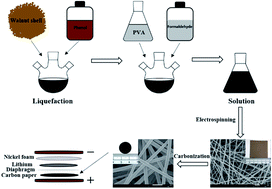Liquefied walnut shell-derived carbon nanofibrous mats as highly efficient anode materials for lithium ion batteries
Abstract
Mechanically flexible walnut shell-derived carbon nanofibers (CNFs) of 175 nm diameter were fabricated from a liquefied walnut shell—polyvinyl alcohol (PVA) hybrid solution via conventional electrospinning followed by one-step carbonization. The morphology and structure properties, as well as pore structure properties of walnut shell-derived CNFs were comprehensively characterized by field-emission scanning electron microscopy (FE-SEM), X-ray photoelectron spectroscopy (XPS), Raman spectroscopy, and their electrochemical performances were evaluated for the first time as electrode materials in lithium ion batteries, without addition of any conductive agent or binder. The walnut shell-derived CNFs mats exhibited a high specific capacity above 150 mA h g−1 with an initial efficiency of 50.4% at a current density of 100 mA g−1 and good cycle stability at different current rates (above 200 and 120 mA h g−1 at 20 and 1000 mA g−1, respectively). After 100 cycles at a current density of 100 mA g−1, walnut shell-derived CNF mats still maintained a good capacity of about 150 mA h g−1. This demonstrated the great prospect of walnut shell-derived CNF mats as electrode materials for applications in electrical energy storage.



 Please wait while we load your content...
Please wait while we load your content...